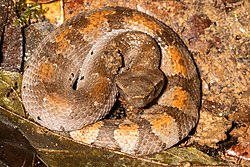| Image | Species | Common name | Geographic range |
|---|
| Bothrocophias andianus (Amaral, 1923) | | Bolivia and Peru |
 | Bothrocophias campbelli (Freire-Lascano, 1991) | Campbell's toadheaded viper the Ecuadorian toadheaded pitviper víbora boca de sapo | Ecuador |
| Bothrocophias colombianus (Rendahl & Vestergren, 1940) | Colombian toad-headed pitviper | Colombia |
 | Bothrocophias hyoprora (Amaral, 1935) | Amazonian toad-headed pitviper | Ecuador, Colombia, Brazil, Peru, and Bolivia |
| Bothrocophias lojanus (Parker, 1930) | Lojan lancehead macanchi macaucho | Ecuador, Peru |
 | Bothrocophias microphthalmus (Cope, 1876) | small-eyed toad-headed pit viper | Ecuador, Peru, Bolivia, Colombia and Brazil |
| Bothrocophias myersi (Gutberlet & Campbell, 2001) | Myers toadheaded pitviper | Colombia |
| Bothrocophias myrringae Angarita-Sierra, Cubides-Cubillos, & Hurtado-Gómez, 2022 | High-Andean Toad-Headed Pitviper | Colombia |
| Bothrocophias tulitoi Angarita-Sierra, Cubides-Cubillos, & Hurtado-Gómez, 2022 | | Colombia |


